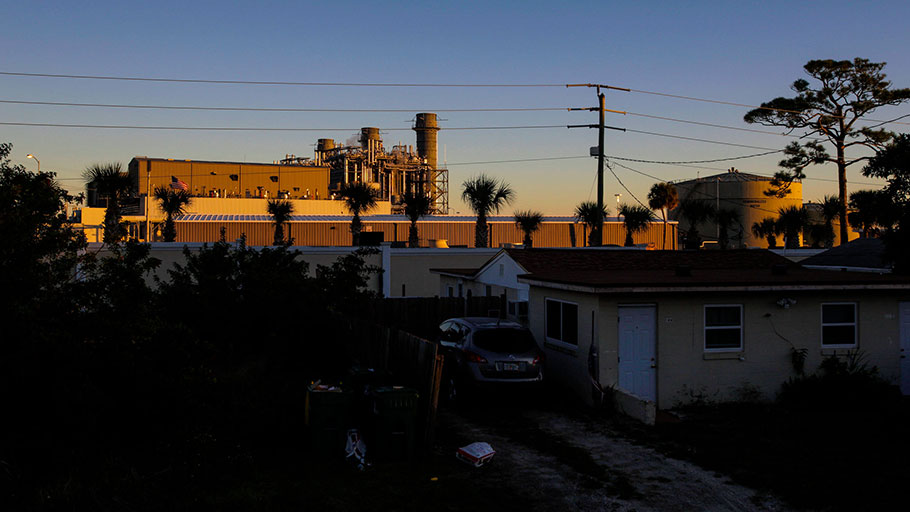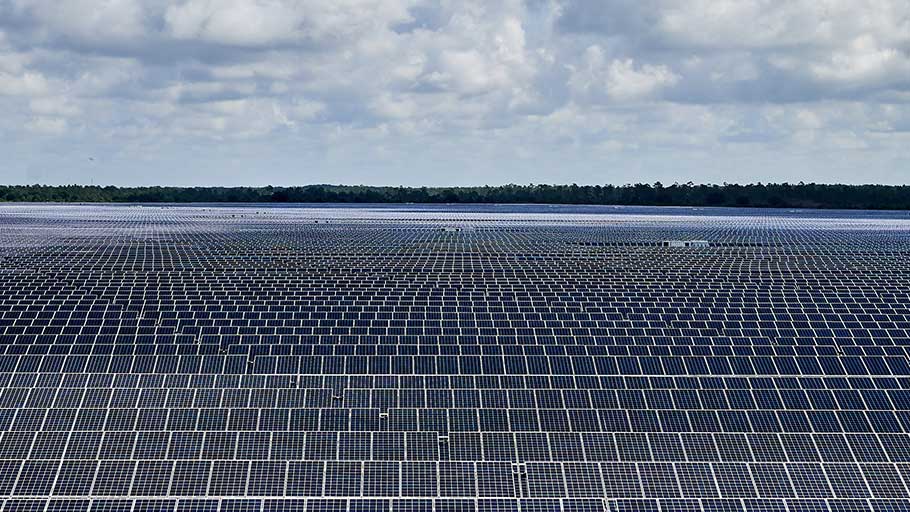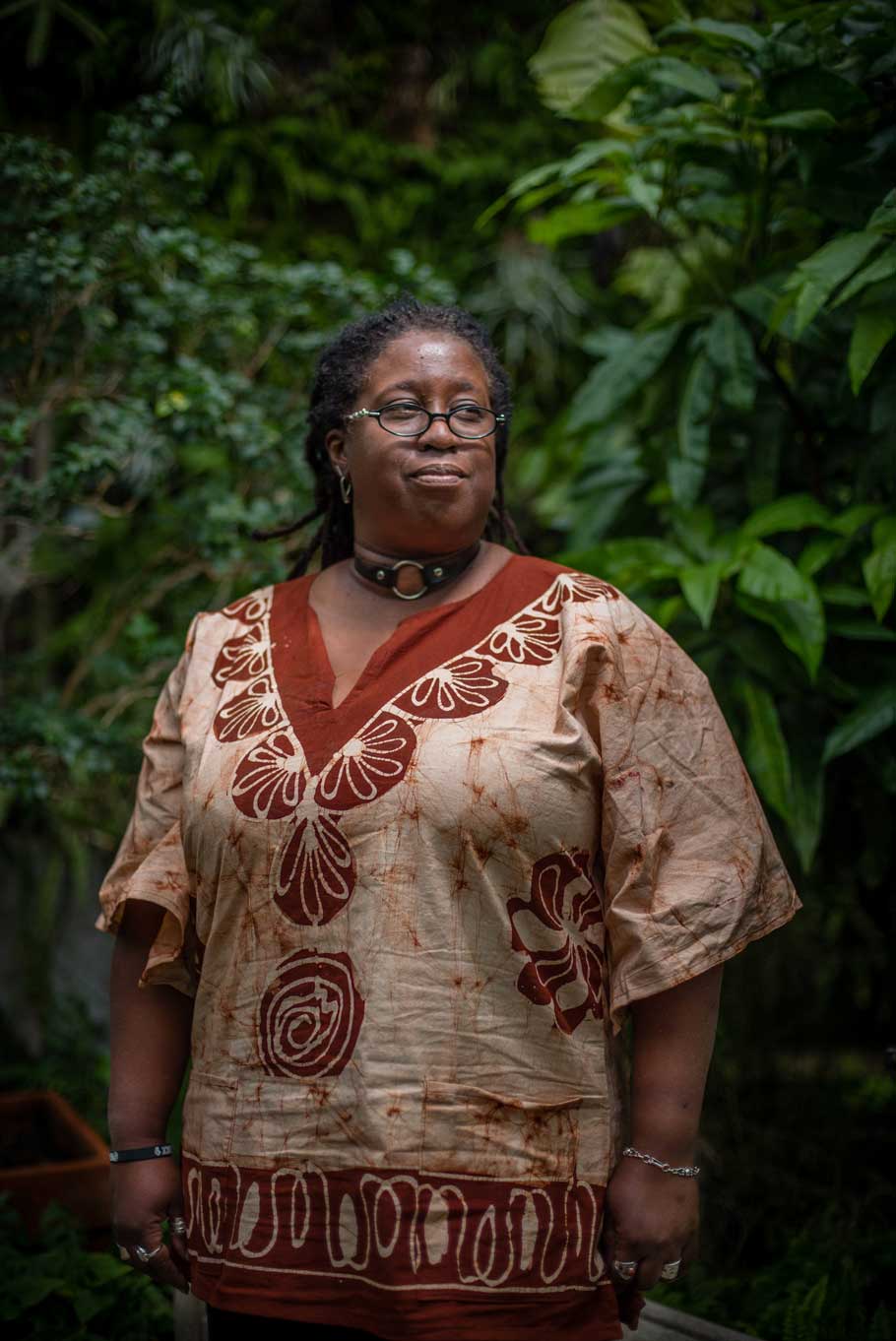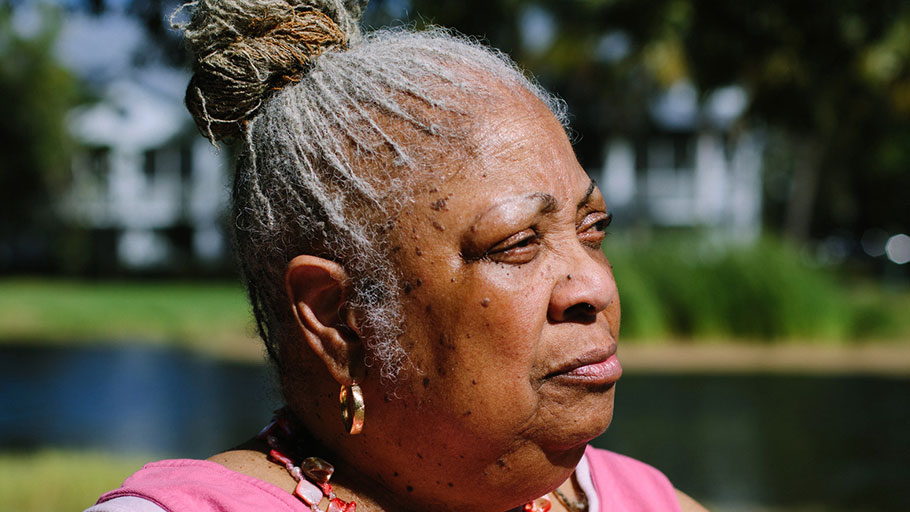Adora Nweze, president of the Florida conference of the N.A.A.C.P., repeated energy industry talking points in articles and testimony, but later concluded that such advocacy was mistaken. Photo – Rose Marie Cromwell for The New York Times.
The civil rights group is trying to stop state and local branches from accepting money from utilities that promote fossil fuels and then lobbying on their behalf.
By Ivan Penn, New York Times —
When utilities around the country have wanted to build fossil-fuel plants, defeat energy-efficiency proposals or slow the growth of rooftop solar power, they have often turned for support to a surprisingly reliable ally: a local chapter of the National Association for the Advancement of Colored People.
In 2014, the top officials of the N.A.A.C.P.’s Florida division threw their organization’s weight behind an effort to stymie the spread of solar panels on residential rooftops and cut energy efficiency standards at the behest of the energy industry. The group’s Illinois chapter joined a similar industry effort in 2017. And in January 2018, the N.A.A.C.P.’s top executive in California signed a letter opposing a government program that encourages the use of renewable energy.
Most Americans know the N.A.A.C.P. as a storied civil rights organization that has fought for equal access to public facilities, fairness in housing and equality in education. But on energy policy, many of its chapters have for years advanced the interests of energy companies that are big donors to their programs. Often this advocacy has come at the expense of the black neighborhoods, which are more likely to have polluting power plants and are less able to adapt to climate change.
The activities of the N.A.A.C.P. chapters, which operate with significant autonomy, have so unnerved the group’s national office that it published a report titled the “Top 10 Manipulation Tactics of the Fossil Fuel Industry” in April. It is also sending its staff to state and local chapters to persuade them to fight for policies that reduce pollution and improve public health even at the risk of losing donations from utilities and fossil fuel companies.
From New Orleans to San Diego, consumer and environmental groups have criticized power companies for using their largess in minority communities to get church pastors, nonprofit groups and organizations like the N.A.A.C.P. to back industry objectives.
“The utilities have essentially asked communities of color to be props for them,” said William Funderburk Jr., an environmental lawyer and former board member of the Los Angeles Department of Water and Power. “It appears utilities are turning back the clock a hundred years.”
From 2013 to 2017, 10 of the country’s largest utilities gave about $1 billion in donations. Those contributions often went to groups representing minority communities, and many of the recipients promoted the interests of utilities in front of government regulators, according to the Energy and Policy Institute, an environmental group.
The N.A.A.C.P. has a long record on environmental issues, including fighting to reduce the health threats posed by lead paint and asbestos. But its national office has been slower to stake a clear position on climate change and the pollution caused by power plants. It established a group dedicated to environmental justice only a decade ago.
Derrick Johnson, the N.A.A.C.P.’s president, said the group had established a department dedicated to that work that is larger than any of its other programs, with 11 full-time staff members and three consultants.
“We care about the education of our children,” Mr. Johnson said. “But if the children are in unhealthy environments, we know that it impedes their learning. We care about health and access to health care, so we must care about the decisions that create mega health impacts.”
‘If we wanted the money, we had to do it.’
As solar panels and other renewable energy sources tumbled in price in recent years, making them attractive alternatives to coal and natural gas in power plants, electric utilities in Florida began pressing regulators and lawmakers to limit their growth.
Rooftop solar in particular posed a threat to the utilities. When the electric grid was designed, engineers did not foresee that consumers would generate their own power and even sell it to the utilities. That could reduce revenue for the companies.

Florida Power & Light’s plant in Cocoa, Fla. Invoices obtained by The New York Times show that the utility gave the N.A.A.C.P.’s Florida conference at least $225,000 from 2013 to 2017. Photo – Saul Martinez for The New York Times.
Florida Power & Light, Duke Energy and other utilities argued that as more affluent homeowners installed solar panels and reduced their reliance on the electric grid, lower-income residents would be forced to pay higher rates to maintain power lines. Many energy experts have disputed that argument, saying energy-efficiency programs and increasingly affordable solar panels can reduce electricity costs for low-income households. But utilities have successfully made their case around the country, often with the help of the N.A.A.C.P. and other nonprofit groups that are advocates for communities of color.
In Florida, utilities found a ready partner — for a time — in Adora Nweze, the president of the N.A.A.C.P.’s Florida conference. She and her staff repeated industry talking points in newspaper opinion articles, written comments to state regulators and testimony in public hearings.
Utilities often sought the group’s support around the time that the state conference was in the middle of raising money for programs and its annual gathering, held in September, Ms. Nweze said.
Invoices obtained by The New York Times show that Florida Power & Light gave the N.A.A.C.P. at least $225,000 from 2013 to 2017 and that Duke Energy gave $25,000. Florida Power & Light’s annual donations doubled in 2014 just as the utility was pressing state regulators to restrict rooftop solar power and weaken the state’s energy efficiency goals.
For example, the N.A.A.C.P.’s Florida conference issued a $50,000 invoice to the utility on Sept. 11, 2014, a couple of months after Ms. Nweze wrote an essay in The Tallahassee Democrat opposing a solar-energy rebate program and in support of a utility-backed change to state efficiency goals.
“In many cases, nonparticipants tend to be the poor, creating a shockingly inequitable situation in which high-income households capture all of the benefits while low-income households shoulder all of the costs,” the essay said. Ms. Nweze said her staff wrote that article and similar ones, often copying verbatim from text sent by Florida Power & Light and other utilities.
In addition to the article, the conference filed comments with the state Public Service Commission. The commission later cited those comments in ruling for the utilities. The commission reduced the state’s energy-efficiency goals by about 90 percent.
The utilities’ policy victory in the 2014 case has had a lasting impact.
Florida utilities have some of the country’s least ambitious energy-efficiency goals. The Sunshine State also trails several states, including Massachusetts and New Jersey, in how much electricity it gets from solar panels.

A solar farm in Babcock Ranch, Fla. Florida gets less energy from solar panels than Massachusetts and New Jersey. Photo – Zack Wittman for The New York Times.
Florida Power & Light declined to answer questions about its work with the N.A.A.C.P.’s state conference and other civil rights organizations. The utility said its primary focus had been to keep electricity rates as low as possible.
“We are proud of our longstanding relationship with the N.A.A.C.P. and of our ability to constructively work together on issues that benefit customers,” said Alys Daly, a company spokeswoman.
In an interview, Ms. Nweze said she had signed on because of the utilities’ financial support to her group, and because she believed what executives had told her about solar panels and energy efficiency.
“I felt that if we wanted the money, we had to do it,” she said. “The shortcoming on my part was that I didn’t have the necessary knowledge to know that it was a problem.”
Ms. Nweze, 77, said she decided about two years ago that her advocacy for the utilities was wrong. That was when the N.A.A.C.P.’s national office worked with her conference on a report about the impact that climate change and pollution have on low-income families. The report concluded that seven power plants had a disproportionate impact on people of color. It also found that Latino adults in Florida had the highest prevalence of asthma at some time in their lives and that African-American adolescents were the most likely to have ongoing asthma.
A turning point at the national office
Jacqueline Patterson played an important role in Ms. Nweze’s conversion. Once focused on becoming a teacher, Ms. Patterson, 51, became interested in environmental issues while in Jamaica as a Peace Corps volunteer, in New Orleans as a relief worker after Hurricane Katrina and in sub-Saharan Africa as an official of a nonprofit group that works on health issues.

Jacqueline Patterson leads an environmental justice program for the national N.A.A.C.P. Photo – André Chung for The New York Times.
She often found that local residents were not involved in the discussions when officials debated and decided environmental and energy policy — white men frequently had the final say.
“What struck me after all of that was the number of rooms I went into where I was the only person of color,” Ms. Patterson said. “Too often, we’re just completely not there.”
As Ms. Patterson began recognizing the need for more African-Americans in the climate-change debate, so did the N.A.A.C.P.
The organization saw a growing need to address climate change and clean energy when it was drawn into a debate over a climate bill in Congress in 2009.
A lobbying firm working for the coal industry, Bonner & Associates, had sent out letters opposing the measure that seemed to be from the N.A.A.C.P.’s chapter in Charlottesville, Va. The group’s national office, in Baltimore, felt it had to make clear that it supported the legislation, which would have established a cap-and-trade program to reduce greenhouse-gas emissions. Jack Bonner, the founder of Bonner & Associates, declined to comment.
Then the organization began digging deeper, creating an environmental justice program and appointing Ms. Patterson to lead it.
Under her leadership, the group began connecting the dots between climate change and the impact of disasters like Katrina on African-American communities. The group also took a closer look at how rising sea levels and more intense storms might affect low-income, minority neighborhoods. And it started examining how air pollution from power plants affected nearby residents, many of them black.
“Seeing all of those intersections and more, we really saw this as a civil rights issue,” Ms. Patterson said. “The N.A.A.C.P. is now engaging around pushing for policies and pushing for access to clean energy.”
One of her priorities, Ms. Patterson said, is to educate state conferences and chapters. A milestone was the 2017 report with its Florida conference, which got the state organization to reverse its position on solar panels, energy efficiency and other clean-energy programs.
“I looked at it differently than I do now,” Ms. Nweze said. “The more you look at the issue, you realize this isn’t really working.”
But the national N.A.A.C.P. message has not found traction in every state.
The president of the group’s Illinois conference, Teresa Haley, said that her group typically got $5,000 to $10,000 a year from the energy industry and that the money did not influence the group’s activities. “They do have their lobbyist who contacts us and says, ‘We need your support.’”
Ms. Haley added that her group’s local branches held votes on which initiatives they support, sometimes backing utilities and sometimes opposing them. In 2012, for example, the Chicago branch successfully fought to close two coal-fired power plants in minority neighborhoods.
In California, the N.A.A.C.P. conference has more consistently taken positions that align with those of the state’s largest utilities.
Alice Huffman, the president of that state conference, has signed letters opposing government-run electricity providers known as Community Choice Aggregation, which allow consumers to choose solar power and wind with lower rates while leaving billing and transmission in the hands of investor-owned utilities. Ms. Huffman and the heads of other nonprofit organizations joined the utilities in sending a letter to state regulators contending that those programs could shift more of the grid’s cost to those who could least afford it. Studies have found that those in community choice programs typically have lower electric bills, but that state fees charged for grid maintenance could hurt low-income customers.
California’s three investor-owned utilities have donated about $180,000 to the N.A.A.C.P.’s state conference and its local chapters over the last five years, the companies said. Ms. Huffman and her conference did not respond to requests for comment.
Mr. Funderburk, the environmental lawyer, said the utility donations pressured nonprofit organizations to support the industry in ways undisclosed to members and the public.
“The only way to get real equity is to make things much more transparent,” he said.
Ms. Patterson said the N.A.A.C.P. was working on alternative revenue sources for chapters that stood to lose financial support from utilities.
In Florida, Ms. Nweze said that she realized that reversing support for fossil-fuel interests could jeopardize the state conference’s funding, but that she could no longer ignore the effect of climate change on her members.
“I’m not naïve,” she said. “I’m concerned, but I’m more concerned about the impact on the lives of the people throughout the country and this state in particular.”
This article was originally published by The New York Times.
Featured image: Adora Nweze, president of the Florida conference of the N.A.A.C.P., repeated energy industry talking points in articles and testimony, but later concluded that such advocacy was mistaken. Photo – Rose Marie Cromwell for The New York Times.















